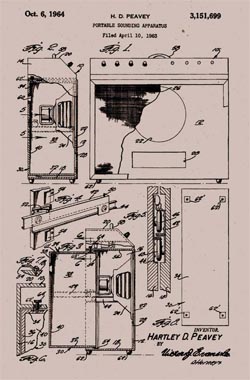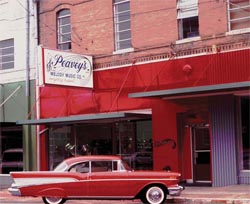SCN: Growing up in and around your father’s music store in Meridian, MS, what prompted you to launch Peavey Electronics Corporation in 1965?
Hartley Peavey: My father was a sax player in a swing band back in the ’30s. He came back to Meridian and started a music store in 1938, met my mom shortly thereafter, and several years later I came along.
- I was raised in his music store, and I’ve had the good fortune to learn the music business from the inside out instead of the usual way. My teenage years spanned the mid- to late-’50s and I experienced the birth of rock ‘n’ roll in the part of the country where it really started.
- In 1957, I went to a Bo Diddley
Hartley Peavey founded Peavey Electronics Corporation in 1965, using the attic space above his father’s Meridian, MS, music store as his first base of operations. Now housed in 27 active facilities across the U.S. and the U.K., Peavey has grown his one-man company into one of the world’s largest manufacturers of musical instruments and professional sound equipment.concert and became entranced by his guitar playing. I spent the next eight years trying to be a guitar player, without much luck. While trying to become a musician, I built my own equipment and gear for several bands that I managed to get into—with each one tossing me out as soon as I completed all the gear they wanted. Musically this was pretty tough, but along the way I discovered what I was really good at: building music and sound gear. When I graduated from college in 1965, I had already started what was to become Peavey. That period was the golden age of the conglomerates where prices skyrocketed and quality plummeted. I knew that I could do it better, and for less! My goal (then and now) was to be the best. Not the biggest, not the most profitable, but the best. Given this, I knew that I could only become the “best” by being different. We were then, and we still are, different! We still believe that it’s the difference that counts.SCN: You founded your business at a time when audio electronics was less an industry than really a “fly by the seat of your pants” kind of scenario. What was your vision for creating a structured, organized manufacturing institution in the free-flowing chaos of that era?
HP: The first time rock ‘n’ roll exploded, it originated in the Mid- South. Back then, most music manufacturing companies were family owned. The second time rock ‘n’ roll exploded was in the early ‘60s, resulting from what most people now call the British Invasion. Rock music exploded again and even bigger, but by then the “golden age of the conglomerate” was in full swing. Huge investment banking firms and conglomerates gobbled up

Peavey has earned more than 180 patents and produces more than 2,000 products, which are distributed throughout the United States and to more than 130 other countries.most music manufacturing firms and rushed in “professionals” from outside the music industry to run things. It was an unmitigated disaster for them and an incredible opportunity for me. They were so keyed into profit that they forgot about the product and the people. I didn’t, and we’re still doing things our way. Incredibly, the last several years have seen this history repeating itself in the music and sound business, with acquisitions once again by huge conglomerates or investment banking firms from outside the industry. Meanwhile, our company continues its quest to be the best by keeping the passion alive for the product, keeping the performance high and doing the best we can to keep the product profitable for our dealers, contractors, and installers.
SCN: Peavey Electronics has been home to many firsts, including the first power amplifiers to offer 400 watts per channel and the first computer-configurable audio system with MediaMatrix. How did you foster the innovation that has earned the company more than 180 patents?
HP: The reason that our company has been able to gain so many patents is that we continue to focus on better ways of doing things. When I started back in ’64-’65, I built the only thing that I knew how to build, and that was relatively simple MI amplifiers and sound systems. That was 44 years ago!
In a very real way, Peavey (including myself) has had 44 years to evolve. Nearly all of our competitors have gone through multiple changes of ownership, management, or location. In that time, and with each change, came a new set of learning curves and mistakes that were repeated. Not so with Peavey. I still have the authority to do what I know is right, instead of having to please some venture capital group or financial guys sitting on a board. This is why we make our own loudspeakers, and why we’ve made huge investments in factories, equipment, and technology. We’ve gone into software first with MediaMatrix and
recently for modeling MI amplifiers. Very soon, significant new directions will be announced, all adding to our company’s unbroken 44 years of growth, evolution, focus, and passion to be the best.
I have always been a maverick, and those individuals who have told me over the years, “You can’t do that” or “You can’t compete with soand- so,” just gave me more adrenaline and resolve to do just that. Henry Ford once said, “If you think you can or if you think you can’t, you’re exactly right.” Back in 1964, I thought I could, and since that time I have been. And good Lord willing, there’s a lot more to yet to unfold from Peavey to the world of pro audio and music.
SCN: Peavey and its MediaMatrix, Architectural Acoustics, and Crest Audio brands produce products for real-world applications. How would you say the worlds of performance and commercial sound have changed in terms of the way we hear audio today versus 40 years ago?
HP: Many changes have occurred and continue to occur in pro audio. We introduced the first large-scale digital network audio system, MediaMatrix, in 1993, and we have more installations across the planet than most of our competition combined. From the U.S. Congress to the new Beijing Airport, MediaMatrix is routing their audio. Peavey has also been a significant innovator in many other technologies. Even still, some people do not consider Peavey to be a high-tech company. This is incredible to me, especially given our many firsts and our continual track record of bringing new and innovative technology to the various markets we serve. It’s odd how our industry forgets, very quickly, how often companies come and go in the marketplace. Once-great audio companies in many cases are no longer even viable in pro audio. I, like many others, believe that one of the most important indicators regarding companies and people in our industry is in how long they can survive and prosper in an extremely competitive and techn cally challenging marketplace such as pro audio. I believe our 44-year track record speaks strongly about our technologies, focus and managerial acumen.
SCN: How would you complete the following sentences?
The Peavey legacy… is an illustration that a world-class company can grow and prosper while based in a small Southern city. We’ve done this through determination, talent, and most of all, focusing on being the best by using the latest technologies in our products and in their design and manufacture.
